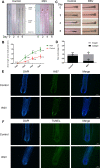Hair Growth-Promoting Effect of Resveratrol in Mice, Human Hair Follicles and Dermal Papilla Cells
- PMID: 34866922
- PMCID: PMC8637427
- DOI: 10.2147/CCID.S335963
Hair Growth-Promoting Effect of Resveratrol in Mice, Human Hair Follicles and Dermal Papilla Cells
Abstract
Background: Oxidative damage has been found in various types of hair loss. As a polyphenolic phytoalexin, resveratrol (RSV) is known as an antioxidant, anti-inflammatory and anti-apoptotic agent.
Objective: Thus, we aim to examine the effects of RSV on hair growth.
Methods: In vivo C57BL/6 mice were used to evaluate the effects of RSV on hair cycle, hair length, skin thickness, hair follicle diameter, hair cycle score and the percentage of hair cycle stage. Then hair shaft length and hair cycle were evaluated by human hair follicles (HFs) ex vivo. The proliferative activities of human dermal papilla cells (hDPCs) cultured in vitro with RSV were assessed using RTCA. The ability of RSV to protect hDPCs against H2O2-induced oxidative damage is examined by a ROS assay kit.
Results: Topical application of RSV significantly promoted hair growth and stimulated the transition of hair cycle from telogen into the anagen phase on shaved C57BL/6 mice. Ex vivo experiments showed that RSV increased the hair shaft length of HFs and delayed the entry into catagen. In vitro experiments indicated that RSV proliferated hDPCs and prevented hDPCs from oxidative damage caused by H2O2.
Conclusion: RSV can promote hair growth and may be a potential candidate for the treatment of hair loss.
Keywords: dermal papilla cells; hair cycle; hair follicle; hair growth; resveratrol.
© 2021 Zhang et al.
Conflict of interest statement
The authors report no conflicts of interest in this work.
Figures





Similar articles
-
Salvianolic Acid B Reduces Oxidative Stress to Promote Hair-Growth in Mice, Human Hair Follicles and Dermal Papilla Cells.Clin Cosmet Investig Dermatol. 2024 Apr 8;17:791-804. doi: 10.2147/CCID.S454844. eCollection 2024. Clin Cosmet Investig Dermatol. 2024. PMID: 38616888 Free PMC article.
-
An extract of Leontopodium alpinum inhibits catagen development ex vivo and increases hair density in vivo.Int J Cosmet Sci. 2022 Jun;44(3):363-376. doi: 10.1111/ics.12783. Epub 2022 Jun 6. Int J Cosmet Sci. 2022. PMID: 35514231 Free PMC article. Clinical Trial.
-
Hair growth-promoting effect of Geranium sibiricum extract in human dermal papilla cells and C57BL/6 mice.BMC Complement Altern Med. 2017 Feb 13;17(1):109. doi: 10.1186/s12906-017-1624-4. BMC Complement Altern Med. 2017. PMID: 28193226 Free PMC article.
-
[Hair growth effect of minoxidil].Nihon Yakurigaku Zasshi. 2002 Mar;119(3):167-74. doi: 10.1254/fpj.119.167. Nihon Yakurigaku Zasshi. 2002. PMID: 11915519 Review. Japanese.
-
STAT5 Activation in the Dermal Papilla Is Important for Hair Follicle Growth Phase Induction.J Invest Dermatol. 2016 Sep;136(9):1781-1791. doi: 10.1016/j.jid.2016.04.014. Epub 2016 Apr 27. J Invest Dermatol. 2016. PMID: 27131881 Review.
Cited by
-
An overview of the genetic aspects of hair loss and its connection with nutrition.J Prev Med Hyg. 2022 Oct 17;63(2 Suppl 3):E228-E238. doi: 10.15167/2421-4248/jpmh2022.63.2S3.2765. eCollection 2022 Jun. J Prev Med Hyg. 2022. PMID: 36479473 Free PMC article. Review.
-
Oxidative stress in hair follicle development and hair growth: Signalling pathways, intervening mechanisms and potential of natural antioxidants.J Cell Mol Med. 2024 Jun;28(12):e18486. doi: 10.1111/jcmm.18486. J Cell Mol Med. 2024. PMID: 38923380 Free PMC article. Review.
-
Morphogenesis, Growth Cycle and Molecular Regulation of Hair Follicles.Front Cell Dev Biol. 2022 May 12;10:899095. doi: 10.3389/fcell.2022.899095. eCollection 2022. Front Cell Dev Biol. 2022. PMID: 35646909 Free PMC article. Review.
-
Potential Natural Products Regulation of Molecular Signaling Pathway in Dermal Papilla Stem Cells.Molecules. 2023 Jul 19;28(14):5517. doi: 10.3390/molecules28145517. Molecules. 2023. PMID: 37513389 Free PMC article. Review.
-
Effects of the Complex of Panicum miliaceum Extract and Triticum aestivum Extract on Hair Condition.Nutrients. 2023 Oct 18;15(20):4411. doi: 10.3390/nu15204411. Nutrients. 2023. PMID: 37892488 Free PMC article.
References
-
- Damodaran RG, Gupta R. Hair loss and the applied techniques for identification of novel hair growth promoters for hair re-growth. Pharmacogn J. 2011;3(22):1–5. doi:10.5530/pj.2011.22.1 - DOI
LinkOut - more resources
Full Text Sources
Research Materials

